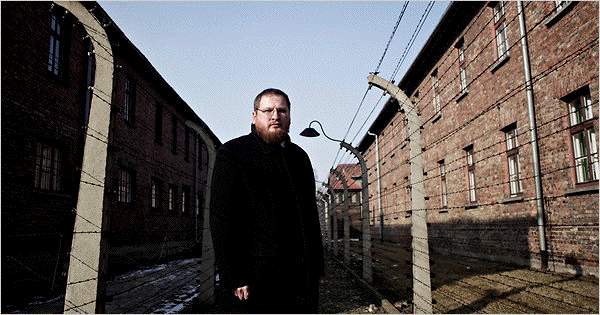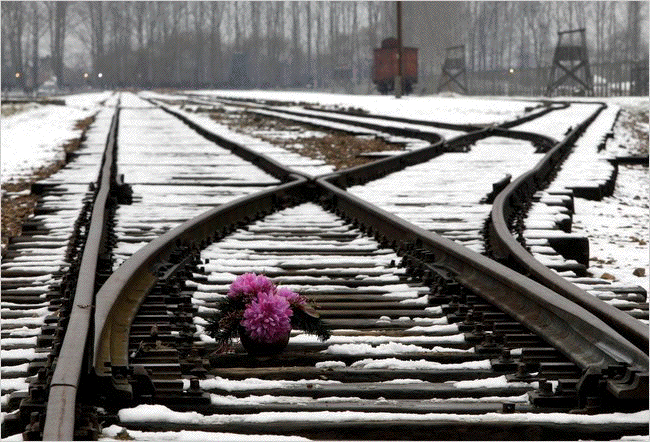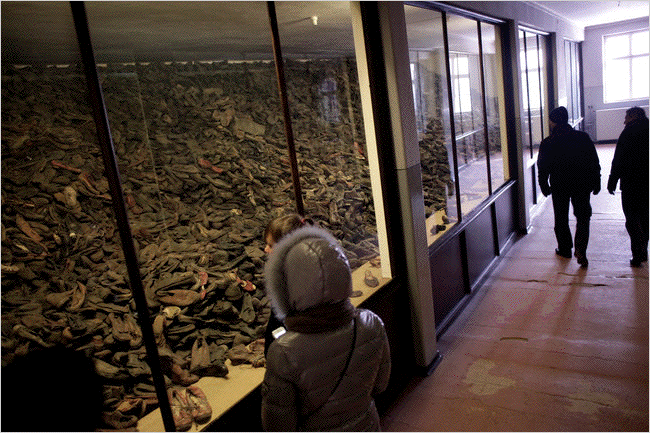
Piotr
Cywinski, the director of the Auschwitz-Birkenau
State Museum in Poland, at the site of the
camp.
OSWIECIM,
Poland -- For nearly 60 years, Auschwitz has told
its own story, shaped in the aftermath of the
Second World War. It now unfolds, unadorned and
mostly unexplained, in displays of hair, shoes and
other remains of the dead. Past the notorious,
mocking gateway, into the brick ranks of the former
barracks of the Polish army camp that the Nazis
seized and converted into prisons and death
chambers, visitors bear witness via this
exhibition.
Now
those in charge of passing along the legacy of this
camp insist that Auschwitz needs an update. Its
story needs to be retold, in a different way for a
different age.
Partly
the change has to do with the simple passage of
time, refurbishing an aging display. Partly it's
about the pressures of tourism, and partly about
the changing of generations. What is the most
visited site and the biggest cemetery in Poland for
Jews and non-Jews alike, needs to explain itself
better, officials here contend.
A
proposed new exhibition at the Auschwitz-Birkenau
State Museum here, occupying some of the same
barracks or blocks, will retain the piled hair and
other remains, which by now have become icons, as
inextricable from Auschwitz as the crematoria and
railway tracks. But the display will start with an
explanatory section on how the camp worked, as a
German Nazi bureaucratic institution, a topic now
largely absent from the present exhibition, which
was devised by survivors during the
1950s.

.Flowers
for victims of Auschwitz, left in January during
ceremonies marking the 66th anniversary of the
camp's liberation.
Back
then they wished to erase the memory of their
tormentors, as the Nazis had tried to erase them,
so they said as little as possible in their
exhibition about the Germans who had conceived and
run the camp. They focused on mass victimhood but
didn't highlight individual stories or testimonials
of the sort that have become commonplace at
memorial museums as devices to translate
incomprehensible numbers of dead into real people,
giving visitors personal stories and characters
they can relate to. Those piles, including
prostheses and suitcases, also stressed the sheer
scale of killing at a time when the world still
didn't comprehend, and much of it refused to admit
to, what really happened here.
As
Marek Zajac, a 31-year-old Polish magazine editor
who serves as secretary for the International
Auschwitz Council, pointed out: "People who visited
after the war already knew what war was, firsthand.
They had lived through it. So the story of a single
death did not necessarily move them, because they
had seen so much death, in their families and in
the streets, whereas the scale of death at
Auschwitz was shocking."
The
new exhibition would go on to describe the process
of extermination, leading visitors step by step
through what victims experienced, and end with a
section on camp life, meaning the "daily
dehumanization and attempts to keep one's
humanity," said Piotr Cywinski, the bearish,
red-bearded 39-year-old Polish director of the
Auschwitz-Birkenau State Museum.
"If
we succeed we will show for the first time the
whole array of human choices that people faced at
Auschwitz," he explained. "Our role is to show the
human acts and decisions that took place in extreme
situations here --the diversity of thinking and
reasoning behind those decisions and their
consequences. So, we may pose the question, should
a mother give a child to the grandmother and go to
selection alone, or take the child with her? This
was a real choice, without a good solution, but at
Auschwitz you had to make the choice."
A
barrack once used for sterilization experiments,
one of the few left nearly undisturbed since the
war, may be reopened, and a new visitor center,
replacing the cramped one in use today, constructed
to handle crowds. There will be few bells and
whistles, Mr. Cywinski insisted, few if any videos
or touch-screens in the main galleries, which would
be impractical for masses of people. Nothing must
overshadow the evidence of the site itself, he
stressed.
"The
more we use special effects," he said, "the more we
draw attention away from the authenticity of this
place, which is unlike any other."
All
or nearly all visitors will be shepherded by guides
to field questions and keep crowds
moving.
That
changes to Auschwitz must entail first of all
calculating how to move increasingly large masses
of people more efficiently, effectively and swiftly
through the site is an uncomfortable turn of
history lost on no one here. An explosion of mass
tourism, dark tourism and education programs in
Europe and elsewhere that send students abroad, has
tripled the number of visitors to Auschwitz over
the last decade. Some 450,000 people a year visited
Auschwitz in 2000. Last year, that number was 1.38
million.

.Exhibitions
of shoes, suitcases and other items taken from
those murdered at Auschwitz illustrate the scale of
the killing.
The
increase --most obvious during warm months in the
long, crawling lines and oceans of visitors pouring
into and out of the narrow barracks onto fleets of
buses to Auschwitz II, or Birkenau, the vast
extermination camp the Nazis built a few miles
away-- has strained an antique exhibition conceived
when not many people came. Today, travel agencies
in Krakow hawk daylong tours combining Auschwitz
with the picturesque Wieliczka salt mine, with its
rock salt chapel, sculptures and
chandeliers.
"We
must take into consideration that more and more
people just drop by," Mr. Zajac said. "We may not
endorse this tourism, but we don't charge
admission. This is a cemetery. You don't charge
admission to a cemetery."
The
gradual passing of survivors has also meant that
Auschwitz faces a historical turning
point.
"Teenagers
now have grandparents born after the war," Mr.
Cywinski noted. "This is a very big deal. Your
grandparents are your era but your
great-grandparents are history.
"The
exhibition at Auschwitz no longer fulfills its
role, as it used to," he continued. "More or less
eight to 10 million people go to such exhibitions
around the world today, they cry, they ask why
people didn't react more at the time, why there
were so few righteous, then they go home, see
genocide on television and don't move a finger.
They don't ask why they are not righteous
themselves.
"To
me the whole educational system regarding the
Holocaust, which really got under way during the
1990s, served its purpose in terms of supplying
facts and information. But there is another level
of education, a level of awareness about the
meaning of those facts. It's not enough to cry.
Empathy is noble, but it's not enough."
This
is the theme to which officials here return often.
Auschwitz, they say, must find ways to engage young
people (some 850,000 students came last year), so
they leave feeling what the director called
"responsibility to the present."
Exactly
how that might be accomplished, if it can be, he
admitted remains to be fleshed out in the questions
and historical information presented by the
exhibition and the tour guides. The very notion
that people increasingly see Auschwitz as ancient
history, that the site, with its haunted ruins,
might no longer speak for itself but needs to be
made relevant to a new century &emdash; all this
reflects a wider change in education and
scholarship about the Holocaust, and also the
special burden felt by officials at Auschwitz.
"Auschwitz is a pillar of postwar Europe,"
Mr. Cywinski said, "and the key to
understanding today."
Each
generation has gotten the stories it wants from the
site. Under Communism, Auschwitz served as a
national memorial to Polish political prisoners,
who were the camp's first victims. Birkenau, where
hundreds of thousands of Jews from Poland, France,
Germany, Hungary, the former Soviet Union and
elsewhere were murdered, lapsed into neglect,
because it didn't fit the narrative.
After
the Berlin Wall fell, painful struggles between
Roman Catholics and Jews erupted over what was in
effect symbolic "ownership" of Auschwitz, as a
place of martyrdom and mourning, which led, among
other things, to the creation of the international
council, a board of advisors under the authority of
Poland's prime minister, which includes survivors,
museum directors, clergy, scholars and
representatives of Jewish, Roma and other
groups.
The
international council could convene as early as
June to review the proposed changes to the
exhibition; an international competition would
follow for a designer, and perhaps by 2015, Mr.
Cywinski said, a new exhibition might open. The $20
million cost, including necessary preservation work
on the buildings, would be paid by the Polish
government.
Mr.
Cywinski is also looking to raise some $160 million
more for an endowment to preserve the whole of
Auschwitz and Birkenau, which requires millions of
dollars a year in conservation. Germany has
committed $81.5 million, Austria $8 million, and
the United States pledged $15 million, so
far.
"This
may sound boring," Mr. Zajac said, "but I believe
tending to this place is a debt to the victims. I
sometimes meet students whom I met here years ago,
now grown, who say they were changed by their
visit, who became responsible people, dedicated to
charity, leading ethical lives."
He
said many of them feel compelled to return: "They
feel ashamed to admit this because it sounds weird,
but they miss the place. They need to go
back."
"I
share this feeling," he continued. "When I am at
Auschwitz I start looking at the world and at my
own life. I remind myself of what's important,
which is so easy to forget. In the kingdom of death
you can find the meaning of life. At the biggest
cemetery in the world I know what I live for."

|